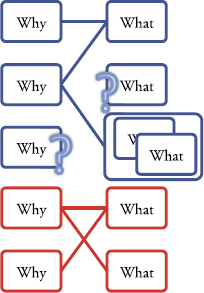Filter and Focus
You've probably seen a movie where the characters seem to have little motivation, where the relationships among them are contrived, resulting in the story limping along without purpose. The problem in these movies is the same one we see in many presentations: weak or nonexistent relationships among the parts.
To make the connections explicit, it is time to link together all the reasons “Why” from Chapter 4 with “What” to change. Each of the things, people, or processes that will change should link to one or more of the reasons “Why.” This helps you to make sure that you aren't considering a change without knowing why. You can skip forward a few pages to the City University Hospital example later in this chapter to see this process with real data, but here we want to use a simpler graphic to explain the process for linking the “Why” and “What” content together.
This process is iterative and may require you to group and break up content to get to a consistent level. We've been asked many times what the right level is, but there is no right answer. It all depends on the level of detail needed for the story.

This is the first time you will link items of content together. It will not be the last. So get started and use the time to develop a good understanding of the relationships. You just need to follow these four rules:
- If almost every “Why” is connected to almost ...
Get Stories that Move Mountains: Storytelling and Visual Design for Persuasive Presentations now with the O’Reilly learning platform.
O’Reilly members experience books, live events, courses curated by job role, and more from O’Reilly and nearly 200 top publishers.

